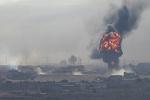Asia and the Pacific is the most disaster prone region in the world. According to the latest report by the United Nations Economic and Social Commission for Asia and the Pacific (ESCAP), during the past decade the region was struck by 1,625 disasters—over 40 per cent of the global total – and half a million people lost their lives. More than 1.4 billion people were affected by these natural disasters, constituting 80 per cent of those affected globally.
The region has incurred substantial economic damage of more than half a trillion dollars over the same period, accounting for close to half the global total. These figures are gross underestimates, since there is no standardised methodology for collecting disaster statistics, and as a result many disasters go unreported.
The 2015 Asia-Pacific Disaster Report – Disasters without borders: regional resilience for sustainable development, being launched in Bangkok on Tuesday, 27 October, highlights the fact that the region’s existing risks are exacerbated and new risks are created, by rapid economic growth, rising population, burgeoning cities, and the consequent impact these interrelated processes have on environmental buffers.
“It is a grave concern that disasters are becoming more frequent, much larger and more intense. As the report highlights, the majority of the disasters in our region are cross-border in nature. This is clearly demonstrated by the earthquake that struck the Alpine-Himalayan belt yesterday, affecting Afghanistan, Pakistan parts of India and Tajikistan,” said Dr. Shamshad Akhtar, United Nations Under-Secretary-General and Executive Secretary of ESCAP. “Only by coming together in the spirit of cooperation can the Asia-Pacific region hope to become truly disaster resilient.”
The report illustrates successful cases where countries in the region work together, such as the region’s spacefaring countries that share technology, information and expertise for disaster preparedness. It identifies areas that lack strong cooperation, especially cross-border floods and landslides.
While investing in disaster risk reduction is proven cost effective, the report identifies several “neglected” disaster management issues that put people, cities, infrastructure and economies at risk. Drought, for example, a forgotten disaster in the region, pushes vast numbers of people into debt, poverty, and sometimes suicide. The report shows how the impact can be mitigated by treating drought as a long-term, recurring risk. The report also analyses the value of multi-hazard early warning systems and maps out the way to provide right information to right people at the right time.
"A fundamental rethink is needed as many governments still follow a short-sighted approach to disasters—with the focus on response, and paying less attention to adaptation, mitigation and preparedness,” said Dr. Akhtar.
The report presents a framework for integrating disaster risk reduction into sustainable development plans, policies, sectoral programs and budgets, noting that just as every sector can be affected by earthquakes, floods or cyclones, it is essential that every sector considers how to make its activities disaster resilient.
It was launched in the context of the ESCAP Committee on Disaster Risk Reduction which begins today in Bangkok, at which senior policy makers from across Asia and the Pacific will discuss how to build regional resilience in the context of newly agreed sustainable development goals.
The full report is available here.
MS/PR


























Your Comment